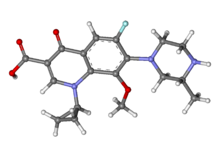Gatifloxacin
 |
|
 |
|
| Clinical data | |
|---|---|
| Trade names | Zymar |
| AHFS/Drugs.com | Monograph |
| MedlinePlus | a605012 |
| Routes of administration |
Oral (discontinued), Intravenous (discontinued) ophthalmic |
| ATC code | |
| Legal status | |
| Legal status |
|
| Pharmacokinetic data | |
| Protein binding | 20% |
| Biological half-life | 7 to 14 hours |
| Identifiers | |
|
|
| CAS Number | |
| PubChem CID | |
| DrugBank | |
| ChemSpider | |
| UNII | |
| KEGG | |
| ChEBI | |
| ChEMBL | |
| NIAID ChemDB | |
| ECHA InfoCard | 100.190.526 |
| Chemical and physical data | |
| Formula | C19H22FN3O4 |
| Molar mass | 375.394 g/mol |
| 3D model (Jmol) | |
|
|
|
|
Gatifloxacin sold under the brand names Gatiflo, Tequin and Zymar, is an antibiotic of the fourth-generation fluoroquinolone family, that like other members of that family, inhibits the bacterial enzymes DNA gyrase and topoisomerase IV. Bristol-Myers Squibb introduced Gatifloxacin in 1999 under the proprietary name Tequin for the treatment of respiratory tract infections, having licensed the medication from Kyorin Pharmaceutical Company of Japan. Allergan produces it in eye-drop formulation under the names Zymar and Zymaxid. In many countries, gatifloxacin is also available as tablets and in various aqueous solutions for intravenous therapy.
A Canadian study published in the New England Journal of Medicine in March 2006 claims Tequin can have significant side effects including dysglycemia. An editorial by Dr. Jerry Gurwitz in the same issue called for the Food and Drug Administration (FDA) to consider giving Tequin a black box warning. This editorial followed distribution of a letter dated February 15 by Bristol-Myers Squibb to health care providers indicating action taken with the FDA to strengthen warnings for the medication. Subsequently it was reported on May 1, 2006 that Bristol-Myers Squibb would stop manufacture of Tequin, end sales of the drug after existing stockpiles were exhausted, and return all rights to Kyorin.
...
Wikipedia
